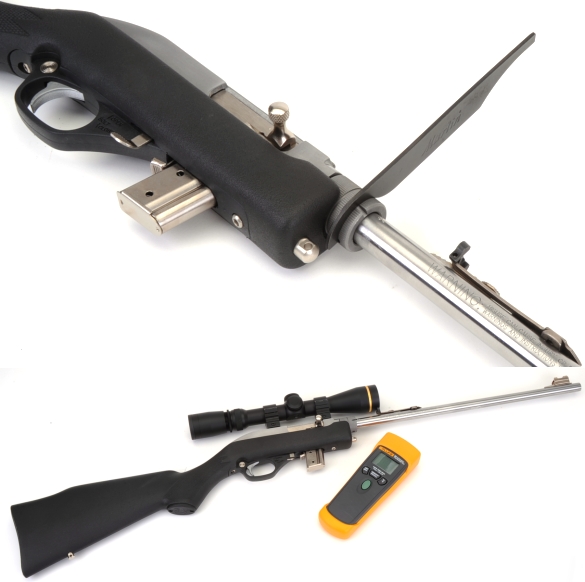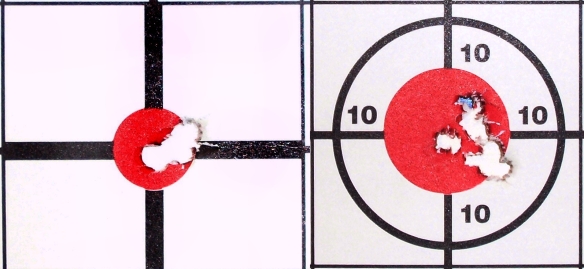
Based on the semiautomatic, tubular magazine Marlin 60 of 1960, the Marlin Model 70P Papoose, was introduced in 1986. This stainless steel version was re-introduced in 2011, produced in Remington manufacturing facilities. So what can the Papoose do that a… non-papoose cannot?

Unscrew the knurled takedown nut and the barrel can be removed. Both parts can then be stowed in a tidy 21″ long padded soft case that holds a stock mounted action, barrel, spanner wrench and trigger lock. You may think I just gave away the ending of this story, however, the product is not without its ambiguities and unresolved mysteries.
I searched through the packing material and found no Algonquian infant. Furthermore, I was not able to successfully place an infant of any origin in the included soft case and carry it on my back. My best guess is that this is some sort of marketing ploy that suggests that the rifle can be taken down, made small and carried in it’s padded, floatable Cordura® carrying case.

The Marlin Model 70 PSS sights are made of alloy steel with a satin nickel finish. The rear semi buckhorn leaf is blackened to contrast with the bright orange front sight. Not fiber optic, but bright just the same. The windowed hood is a nice touch. Something I do to my Marlin Guide Guns; a top window to illuminate the front sight while still providing framing and brush guarding functions. The rear sight is stepped elevation adjustable and drift adjustable for windage.
This can’t be good, or is it?
When I posted images of the Model 70 PSS, two people immediately, and quite dramatically responded with reports of “scope drifting”. which I assumed meant point of impact drifting. It was explained that because the barrel is removable and the scope is mounted on the receiver, the scope zero drifts when the barrel heats up.

An interesting theory, except the same would apply to just about every rimfire from the Remington Nylon 66 and Browning Semi Auto 22 to the Ruger 10/22 and CZ 455. All rifles with an assortment of collars or set screws to hold the barrel in place, all with metallic sights on the barrel and scope mounted in the receiver. The Marlin’s barrel was installed using the included spanner wrench to tighten the barrel nut as covered in the rifle’s manual. A Leupold scope with 1″ rings was mounted to the rifle’s 3/8″ grooved receiver. I broke out a Fluke infrared thermometer and hauled the little Papoose, if that’s what its name really is, to the range.

The only care exercised was to shoot from a rest and to not support the rifle at the barrel, but rather from the stock, just ahead of the detachable magazine. Both groups were shot at 25 yards, each square in each target measures 1″ inch square. The first, a 5 shot group, was shot with the barrel at 71.1ºF. Then 21 rounds, three magazines, were fired without a cool down period. At the highest temperature, 74.7ºF, 14 shots, 2 magazines were fired at a second target, pictured right. The first measures less than 0.3″ center to center, the second less than 0.5″.

Both groups started essentially at the same point on the bullseye with the second group slightly more dispersed. I would attribute that to being interrupted to reload and to firing 9 additional shots, not a temperature induced point of impact shift. No, I did not run a scientifically legitimate number of samples and I did not run multiple temperature cycles for a significant analysis. But if the Marlin Model 70 PSS had an issue with barrel temperature as common as suggested, it would have showed up as some point within an afternoon of shooting. It did not.
But how did it shoot?
|
Marlin Model 70 PSS |
|
| Point of Origin | Mayfield, Kentucky |
| Model | 70 PSS |
| Type Action | Semi Auto |
| Caliber | 22 Long Rifle |
| Mag Capacity | 7 |
| Barrel Length | 16.25″ |
| Rifling Twist | 1:16″ RH Micro-Groove |
| Weight | 3.25 Lbs |
| Overall Length | 35.25″ |
| Stock | Dark Gray Synthetic |
| Receiver | Stainless Steel |
| Barrel | Stainless Steel |
| Length of Pull | 13.75″ |
| Drop at comb | 1.00″ |
| Drop at heel | 1.75″ |
| Rear Sight | Adjustable Elevation |
| Front Sight | Orange Bead |
| Scope Mount | 3/8″ Grooved Receiver |
| Trigger Pull | 5Lbs 4 Oz |
| Safety | Cross Bolt |
| MSRP | $328 |
|
Nominal Weights & Measures |
|
It took a while before the rifle feel… intuitive. Initially, I kept reaching for the non-existent forearm until I came to accept the rifle balanced just ahead of the magazine and the it was easy to accomplish a steady hold. The metallic sights are actually very good and for the range of a 22 LR more than adequate for anything other than critical work. Mounting a scope is not a futile effort as the rifle is accurate.
The Model 70 cycled reliably with both standard and high velocity ammo. The last shot bolt hold open feature also worked reliably. Controls were in the right place, including the bolt release, and magazine changes were uncomplicated.
The rifle is very light, but it is very durable. The fiberglass filled synthetic stock, stainless steel and nickel plated pieces make the firearm durable and all weather.
Would the take down feature be useful? Traveling by motorcycle, the Model 70 would stow handily. Hiking with a backpack, a trip to a remote fishing location, stowed in a boat, a camp gun for small game hunting or some recreational target shooting? All good applications. Any application where take down would be convenient.
Things I would like to see? Larger capacity magazines would be useful, but not necessary. I just get lazy when I am shooting rimfire rifles and would like to stop to reload fewer than every 7 shots. I would like to see the same type but matte black front and rear sights and a bead blasted barrel. Something to cut reflective surfaces. That’s it. Nifty little rifle, accurate and fun to shoot.

Email Notification